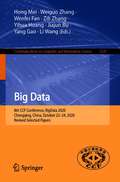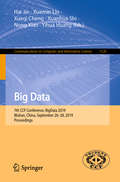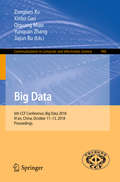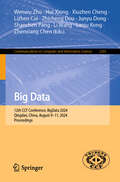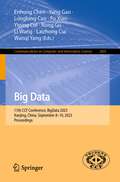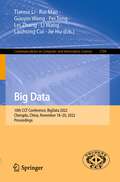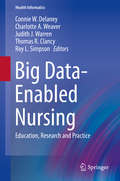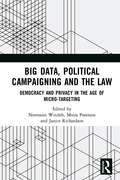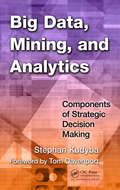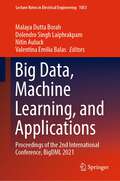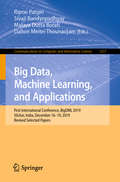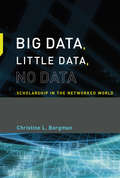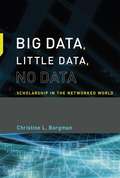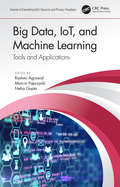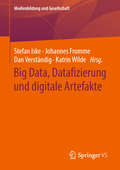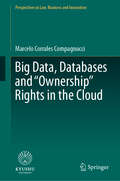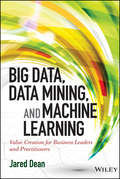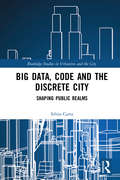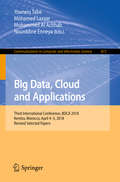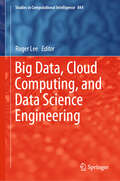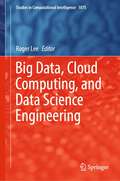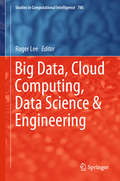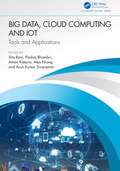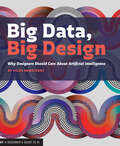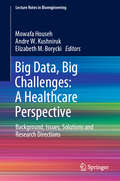- Table View
- List View
Big Data: 8th CCF Conference, BigData 2020, Chongqing, China, October 22–24, 2020, Revised Selected Papers (Communications in Computer and Information Science #1320)
by Li Wang Yang Gao Zili Zhang Hong Mei Jiajun Bu Yihua Huang Weiguo Zhang Wenfei FanThis book constitutes the proceedings of the 8th CCF Conference on Big Data, BigData 2020, held in Chongqing, China, in October 2020.The 16 full papers presented in this volume were carefully reviewed and selected from 65 submissions. They present recent research on theoretical and technical aspects on big data, as well as on digital economy demands in big data applications.
Big Data: 7th CCF Conference, BigData 2019, Wuhan, China, September 26–28, 2019, Proceedings (Communications in Computer and Information Science #1120)
by Hai Jin Xuemin Lin Xuanhua Shi Xueqi Cheng Nong Xiao Yihua HuangThis book constitutes the proceedings of the 7th CCF Conference on Big Data, BigData 2019, held in Wuhan, China, in October 2019.The 30 full papers presented in this volume were carefully reviewed and selected from 324 submissions. They were organized in topical sections as follows: big data modelling and methodology; big data support and architecture; big data processing; big data analysis; and big data application.
Big Data: 6th CCF Conference, Big Data 2018, Xi'an, China, October 11-13, 2018, Proceedings (Communications in Computer and Information Science #945)
by Xinbo Gao Qiguang Miao Zongben Xu Yunquan Zhang Jiajun BuThis volume constitutes the proceedings of the 6th CCF Conference, Big Data 2018, held in Xi'an, China, in October 2018. The 32 revised full papers presented in this volume were carefully reviewed and selected from 880 submissions. The papers are organized in topical sections on natural language processing and text mining; big data analytics and smart computing; big data applications; the application of big data in machine learning; social networks and recommendation systems; parallel computing and storage of big data; data quality control and data governance; big data system and management.
Big Data: 12th CCF Conference, BigData 2024, Qingdao, China, August 9–11, 2024, Proceedings (Communications in Computer and Information Science #2301)
by Hui Xiong Li Wang Wenwu Zhu Zhicheng Dou Xiuzhen Cheng Zhenxiang Chen Lizhen Cui Junyu Dong Shanchen Pang Lanju Kong“This book constitutes the refereed proceedings of the 12th CCF Conference on BigData 2024, which took place in Qingdao, China, in August 2024” to “This book constitutes the refereed proceedings of the 12th CCF Conference on BigData 2024, which took place in Qingdao, China, during 9-11 August, 2024. The 26 full papers presented in this volume were carefully reviewed and selected from 219 submissions. The topics of accepted papers include Big data, Data Science, System Architecture and Infrastructure, Storage Management, Parallel Computing, Analysis Mining and Intelligent Computing, Collection and Preprocessing, Governance.
Big Data: 11th CCF Conference, BigData 2023, Nanjing, China, September 8–10, 2023, Proceedings (Communications in Computer and Information Science #2005)
by Longbing Cao Li Wang Yang Gao Fu Xiao Laizhong Cui Enhong Chen Yiping Cui Rong Gu Wanqi YangThis book constitutes the refereed proceedings of the 11th CCF Conference on BigData 2023, which took place in Nanjing, China, in September 2023. The 14 full papers presented in this volume were carefully reviewed and selected from 69 submissions. The topics of accepted papers include theories and methods of data science, algorithms and applications of big data.
Big Data: 10th CCF Conference, BigData 2022, Chengdu, China, November 18–20, 2022, Proceedings (Communications in Computer and Information Science #1709)
by Lei Zhang Li Wang Tianrui Li Guoyin Wang Jie Hu Rui Mao Laizhong Cui Fei TengThis book constitutes the refereed proceedings of the 10th CCF Conference on BigData 2022, which took place in Chengdu, China, in November 2022. The 8 full papers presented in this volume were carefully reviewed and selected from 28 submissions. The topics of accepted papers include theories and methods of data science, algorithms and applications of big data.
Big Data-Enabled Nursing: Education, Research and Practice (Health Informatics)
by Charlotte A. Weaver Connie W. Delaney Judith J. Warren Thomas R. Clancy Roy L. SimpsonHistorically, nursing, in all of its missions of research/scholarship, education and practice, has not had access to large patient databases. Nursing consequently adopted qualitative methodologies with small sample sizes, clinical trials and lab research. Historically, large data methods were limited to traditional biostatical analyses. In the United States, large payer data has been amassed and structures/organizations have been created to welcome scientists to explore these large data to advance knowledge discovery. Health systems electronic health records (EHRs) have now matured to generate massive databases with longitudinal trending. This text reflects how the learning health system infrastructure is maturing, and being advanced by health information exchanges (HIEs) with multiple organizations blending their data, or enabling distributed computing. It educates the readers on the evolution of knowledge discovery methods that span qualitative as well as quantitative data mining, including the expanse of data visualization capacities, are enabling sophisticated discovery. New opportunities for nursing and call for new skills in research methodologies are being further enabled by new partnerships spanning all sectors.
Big Data, Political Campaigning and the Law: Democracy and Privacy in the Age of Micro-Targeting
by Normann Witzleb Moira Paterson Janice RichardsonIn this multidisciplinary book, experts from around the globe examine how data-driven political campaigning works, what challenges it poses for personal privacy and democracy, and how emerging practices should be regulated. The rise of big data analytics in the political process has triggered official investigations in many countries around the world, and become the subject of broad and intense debate. Political parties increasingly rely on data analytics to profile the electorate and to target specific voter groups with individualised messages based on their demographic attributes. Political micro-targeting has become a major factor in modern campaigning, because of its potential to influence opinions, to mobilise supporters and to get out votes. The book explores the legal, philosophical and political dimensions of big data analytics in the electoral process. It demonstrates that the unregulated use of big personal data for political purposes not only infringes voters’ privacy rights, but also has the potential to jeopardise the future of the democratic process, and proposes reforms to address the key regulatory and ethical questions arising from the mining, use and storage of massive amounts of voter data. Providing an interdisciplinary assessment of the use and regulation of big data in the political process, this book will appeal to scholars from law, political science, political philosophy and media studies, policy makers and anyone who cares about democracy in the age of data-driven political campaigning.
Big Data, Mining, and Analytics: Components of Strategic Decision Making
by Stephan KudybaThere is an ongoing data explosion transpiring that will make previous creations, collections, and storage of data look trivial. Big Data, Mining, and Analytics: Components of Strategic Decision Making ties together big data, data mining, and analytics to explain how readers can leverage them to extract valuable insights from their data. Facilitati
Big Data, Machine Learning, and Applications: Proceedings of the 2nd International Conference, BigDML 2021 (Lecture Notes in Electrical Engineering #1053)
by Valentina Emilia Balas Nitin Auluck Malaya Dutta Borah Dolendro Singh LaiphrakpamThis book constitutes refereed proceedings of the Second International Conference on Big Data, Machine Learning, and Applications, BigDML 2021. The volume focuses on topics such as computing methodology; machine learning; artificial intelligence; information systems; security and privacy. This volume will benefit research scholars, academicians, and industrial people who work on data storage and machine learning.
Big Data, Machine Learning, and Applications: First International Conference, BigDML 2019, Silchar, India, December 16–19, 2019, Revised Selected Papers (Communications in Computer and Information Science #1317)
by Sivaji Bandyopadhyay Ripon Patgiri Malaya Dutta Borah Dalton Meitei ThounaojamThis book constitutes refereed proceedings of the First International First International Conference on Big Data, Machine Learning, and Applications, BigDML 2019, held in Silchar, India, in December.The 6 full papers and 3 short papers were carefully reviewed and selected from 152 submissions. The papers present research on such topics as computing methodology; machine learning; artificial intelligence; information systems; security and privacy.
Big Data, Little Data, No Data: Scholarship in the Networked World (The\mit Press Ser.)
by Christine L. BorgmanAn examination of the uses of data within a changing knowledge infrastructure, offering analysis and case studies from the sciences, social sciences, and humanities.“Big Data” is on the covers of Science, Nature, the Economist, and Wired magazines, on the front pages of the Wall Street Journal and the New York Times. But despite the media hyperbole, as Christine Borgman points out in this examination of data and scholarly research, having the right data is usually better than having more data; little data can be just as valuable as big data. In many cases, there are no data—because relevant data don't exist, cannot be found, or are not available. Moreover, data sharing is difficult, incentives to do so are minimal, and data practices vary widely across disciplines.Borgman, an often-cited authority on scholarly communication, argues that data have no value or meaning in isolation; they exist within a knowledge infrastructure—an ecology of people, practices, technologies, institutions, material objects, and relationships. After laying out the premises of her investigation—six “provocations” meant to inspire discussion about the uses of data in scholarship—Borgman offers case studies of data practices in the sciences, the social sciences, and the humanities, and then considers the implications of her findings for scholarly practice and research policy. To manage and exploit data over the long term, Borgman argues, requires massive investment in knowledge infrastructures; at stake is the future of scholarship.
Big Data, Little Data, No Data
by Christine L. Borgman"Big Data" is on the covers of Science, Nature, the Economist, and Wired magazines, on the front pages of the Wall Street Journal and the New York Times. But despite the media hyperbole, as Christine Borgman points out in this examination of data and scholarly research, having the right data is usually better than having more data; little data can be just as valuable as big data. In many cases, there are no data -- because relevant data don't exist, cannot be found, or are not available. Moreover, data sharing is difficult, incentives to do so are minimal, and data practices vary widely across disciplines.Borgman, an often-cited authority on scholarly communication, argues that data have no value or meaning in isolation; they exist within a knowledge infrastructure -- an ecology of people, practices, technologies, institutions, material objects, and relationships. After laying out the premises of her investigation -- six "provocations" meant to inspire discussion about the uses of data in scholarship -- Borgman offers case studies of data practices in the sciences, the social sciences, and the humanities, and then considers the implications of her findings for scholarly practice and research policy. To manage and exploit data over the long term, Borgman argues, requires massive investment in knowledge infrastructures; at stake is the future of scholarship.
Big Data, IoT, and Machine Learning: Tools and Applications (Internet of Everything (IoE))
by Rashmi Agrawal, Marcin Paprzycki, Neha GuptaThe idea behind this book is to simplify the journey of aspiring readers and researchers to understand Big Data, IoT and Machine Learning. It also includes various real-time/offline applications and case studies in the fields of engineering, computer science, information security and cloud computing using modern tools. This book consists of two sections: Section I contains the topics related to Applications of Machine Learning, and Section II addresses issues about Big Data, the Cloud and the Internet of Things. This brings all the related technologies into a single source so that undergraduate and postgraduate students, researchers, academicians and people in industry can easily understand them. Features Addresses the complete data science technologies workflow Explores basic and high-level concepts and services as a manual for those in the industry and at the same time can help beginners to understand both basic and advanced aspects of machine learning Covers data processing and security solutions in IoT and Big Data applications Offers adaptive, robust, scalable and reliable applications to develop solutions for day-to-day problems Presents security issues and data migration techniques of NoSQL databases
Big Data, Datafizierung und digitale Artefakte (Medienbildung und Gesellschaft #42)
by Johannes Fromme Dan Verständig Stefan Iske Katrin WildeDer Band fokussiert Entwicklungen und Problemstellungen rund um das Verhältnis des Menschen zu Daten und Zahlen sowie die daran geknüpften Implikationen für Medien, Bildung und Gesellschaft. Ausgangspunkte bilden hierbei auf der einen Seite Big Data und Tendenzen der Datafizierung sozialer Prozesse, auf der anderen Seite Transformationen des Ästhetischen im Hinblick auf kreativ-ästhetische Praktiken. Der Band versammelt dabei unterschiedliche theoretische Positionen, die sich gemeinsam an zentralen Fragen der Medienbildung und kulturellen Bildung im digitalen Zeitalter orientieren.
Big Data, Databases and "Ownership" Rights in the Cloud (Perspectives in Law, Business and Innovation)
by Marcelo Corrales CompagnucciTwo of the most important developments of this new century are the emergence of cloud computing and big data. However, the uncertainties surrounding the failure of cloud service providers to clearly assert ownership rights over data and databases during cloud computing transactions and big data services have been perceived as imposing legal risks and transaction costs. This lack of clear ownership rights is also seen as slowing down the capacity of the Internet market to thrive. Click-through agreements drafted on a take-it-or-leave-it basis govern the current state of the art, and they do not allow much room for negotiation. The novel contribution of this book proffers a new contractual model advocating the extension of the negotiation capabilities of cloud customers, thus enabling an automated and machine-readable framework, orchestrated by a cloud broker.Cloud computing and big data are constantly evolving and transforming into new paradigms where cloud brokers are predicted to play a vital role as innovation intermediaries adding extra value to the entire life cycle. This evolution will alleviate the legal uncertainties in society by means of embedding legal requirements in the user interface and related computer systems or its code. This book situates the theories of law and economics and behavioral law and economics in the context of cloud computing and takes database rights and ownership rights of data as prime examples to represent the problem of collecting, outsourcing, and sharing data and databases on a global scale. It does this by highlighting the legal constraints concerning ownership rights of data and databases and proposes finding a solution outside the boundaries and limitations of the law. By allowing cloud brokers to establish themselves in the market as entities coordinating and actively engaging in the negotiation of service-level agreements (SLAs), individual customers as well as small and medium-sized enterprises could efficiently and effortlessly choose a cloud provider that best suits their needs. This approach, which the author calls “plan-like architectures,” endeavors to create a more trustworthy cloud computing environment and to yield radical new results for the development of the cloud computing and big data markets.
Big Data, Data Mining, and Machine Learning
by Jared DeanWith big data analytics comes big insights into profitabilityBig data is big business. But having the data and the computational power to process it isn't nearly enough to produce meaningful results. Big Data, Data Mining, and Machine Learning: Value Creation for Business Leaders and Practitioners is a complete resource for technology and marketing executives looking to cut through the hype and produce real results that hit the bottom line. Providing an engaging, thorough overview of the current state of big data analytics and the growing trend toward high performance computing architectures, the book is a detail-driven look into how big data analytics can be leveraged to foster positive change and drive efficiency.With continued exponential growth in data and ever more competitive markets, businesses must adapt quickly to gain every competitive advantage available. Big data analytics can serve as the linchpin for initiatives that drive business, but only if the underlying technology and analysis is fully understood and appreciated by engaged stakeholders. This book provides a view into the topic that executives, managers, and practitioners require, and includes:A complete overview of big data and its notable characteristicsDetails on high performance computing architectures for analytics, massively parallel processing (MPP), and in-memory databasesComprehensive coverage of data mining, text analytics, and machine learning algorithmsA discussion of explanatory and predictive modeling, and how they can be applied to decision-making processesBig Data, Data Mining, and Machine Learning provides technology and marketing executives with the complete resource that has been notably absent from the veritable libraries of published books on the topic. Take control of your organization's big data analytics to produce real results with a resource that is comprehensive in scope and light on hyperbole.
Big Data, Code and the Discrete City: Shaping Public Realms (Routledge Studies in Urbanism and the City)
by Silvio CartaBig Data, Code and the Discrete City explores how digital technologies are gradually changing the way in which the public space is designed by architects, managed by policymakers and experienced by individuals. Smart city technologies are superseding the traditional human experience that has characterised the making of the public space until today. This book examines how computers see the public space and the effect of algorithms, artificial intelligences and automated processes on the human experience in public spaces. Divided into three parts, the first part of this book examines the notion of discreteness in its origins and applications to computer sciences. The second section presents a dual perspective: it explores the ways in which public spaces are constructed by the computer-driven logic and then translated into control mechanisms, design strategies and software-aided design. This perspective also describes the way in which individuals perceive this new public space, through its digital logic, and discrete mechanisms (from Wi-Fi coverage to self-tracking). Finally, in the third part, this book scrutinises the discrete logic with which computers operate, and how this is permeating into aspects of city life. This book is valuable for anyone interested in urban studies and digital technologies, and more specifically in big data, urban informatics and public space.
Big Data, Cloud and Applications: Third International Conference, Bdca 2018, Kenitra, Morocco, April 4-5, 2018, Revised Selected Papers (Communications In Computer And Information Science #872)
by Youness Tabii Mohamed Lazaar Mohammed Al Achhab Nourddine EnneyaThis book constitutes the thoroughly refereed proceedings of the Third International Conference on Big Data, Cloud and Applications, BDCA 2018, held in Kenitra, Morocco, in April 2018.The 45 revised full papers presented in this book were carefully selected from 99 submissions with a thorough double-blind review process. They focus on the following topics: big data, cloud computing, machine learning, deep learning, data analysis, neural networks, information system and social media, image processing and applications, and natural language processing.
Big Data, Cloud Computing, and Data Science Engineering (Studies in Computational Intelligence #844)
by Roger LeeThis edited book presents the scientific outcomes of the 4th IEEE/ACIS International Conference on Big Data, Cloud Computing, Data Science & Engineering (BCD 2019) which was held on May 29–31, 2019 in Honolulu, Hawaii. The aim of the conference was to bring together researchers and scientists, businessmen and entrepreneurs, teachers, engineers, computer users and students to discuss the numerous fields of computer science and to share their experiences and exchange new ideas and information in a meaningful way. Presenting 15 of the conference’s most promising papers, the book discusses all aspects (theory, applications and tools) of computer and information science, the practical challenges encountered along the way, and the solutions adopted to solve them.
Big Data, Cloud Computing, and Data Science Engineering (Studies in Computational Intelligence #1075)
by Roger LeeThis book presents scientific results of the 7th IEEE/ACIS International Conference on Big Data, Cloud Computing, Data Science & Engineering (BCD 2021) which was held on August 4-6, 2022 in Danang, Vietnam. The aim of this conference was to bring together researchers and scientists, businessmen and entrepreneurs, teachers, engineers, computer users, and students to discuss the numerous fields of computer science and to share their experiences and exchange new ideas and information in a meaningful way. All aspects (theory, applications, and tools) of computer and information science, the practical challenges encountered along the way, and the solutions adopted to solve them are all explored here in the results of the articles featured in this book. The conference organizers selected the best papers from those papers accepted for presentation at the conference. The papers were chosen based on review scores submitted by members of the program committee and underwent further rigorous rounds of review. From this second round of review, 15 of the conference’s most promising papers are then published in this Springer (SCI) book and not the conference proceedings. We impatiently await the important contributions that we know these authors will bring to the field of computer and information science.
Big Data, Cloud Computing, Data Science & Engineering (Studies in Computational Intelligence #786)
by Roger LeeThis book presents the outcomes of the 3rd IEEE/ACIS International Conference on Big Data, Cloud Computing, Data Science & Engineering (BCD 2018), which was held on July 10–12, 2018 in Kanazawa. The aim of the conference was to bring together researchers and scientists, businesspeople and entrepreneurs, teachers, engineers, computer users, and students to discuss the various fields of computer science, to share their experiences, and to exchange new ideas and information in a meaningful way. All aspects (theory, applications and tools) of computer and information science, the practical challenges encountered along the way, and the solutions adopted to solve them are all explored here. The conference organizers selected the best papers from among those accepted for presentation. The papers were chosen on the basis of review scores submitted by members of the program committee and subsequently underwent further rigorous review. Following this second round of review, 13 of the conference’s most promising papers were selected for this Springer (SCI) book. We eagerly await the important contributions that we know these authors will make to the field of computer and information science.
Big Data, Cloud Computing and IoT: Tools and Applications
by Alex Khang Pankaj Bhambri Sita Rani Arun Kumar Sivaraman Aman KatariaCloud computing, the Internet of Things (IoT), and big data are three significant technological trends affecting the world's largest corporations. This book discusses big data, cloud computing, and the IoT, with a focus on the benefits and implementation problems. In addition, it examines the many structures and applications pertinent to these disciplines. Also, big data, cloud computing, and the IoT are proposed as possible study avenues. Features: Informs about cloud computing, IoT and big data, including theoretical foundations and the most recent empirical findings Provides essential research on the relationship between various technologies and the aggregate influence they have on solving real-world problems Ideal for academicians, developers, researchers, computer scientists, practitioners, information technology professionals, students, scholars, and engineers exploring research on the incorporation of technological innovations to address contemporary societal challenges
Big Data, Big Design: Why Designers Should Care about Artificial Intelligence
by Helen ArmstrongBig Data, Big Design provides designers with the tools they need to harness the potential of machine learning and put it to use for good through thoughtful, human-centered, intentional design.Enter the world of Machine Learning (ML) and Artificial Intelligence (AI) through a design lens in this thoughtful handbook of practical skills, technical knowledge, interviews, essays, and theory, written specifically for designers. Gain an understanding of the design opportunities and design biases that arise when using predictive algorithms. Learn how to place design principles and cultural context at the heart of AI and ML through real-life case studies and examples. This portable, accessible guide will give beginners and more advanced AI and ML users the confidence to make reasoned, thoughtful decisions when implementing ML design solutions.
Big Data, Big Challenges: Background, Issues, Solutions and Research Directions (Lecture Notes in Bioengineering)
by Mowafa Househ Andre W. Kushniruk Elizabeth M. BoryckiThis is the first book to offer a comprehensive yet concise overview of the challenges and opportunities presented by the use of big data in healthcare. The respective chapters address a range of aspects: from health management to patient safety; from the human factor perspective to ethical and economic considerations, and many more. By providing a historical background on the use of big data, and critically analyzing current approaches together with issues and challenges related to their applications, the book not only sheds light on the problems entailed by big data, but also paves the way for possible solutions and future research directions. Accordingly, it offers an insightful reference guide for health information technology professionals, healthcare managers, healthcare practitioners, and patients alike, aiding them in their decision-making processes; and for students and researchers whose work involves data science-related research issues in healthcare.
